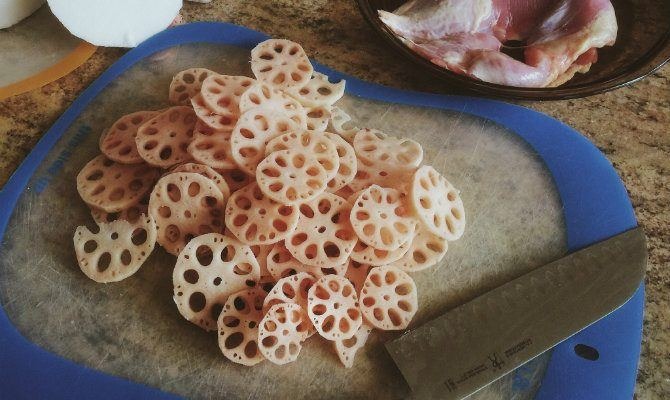Buddhist Vegetarian Stew (Luo Hon Jai)
Buddhist Vegetarian Stew (Luo Hon Jai)
Originally eaten by Buddhists in Chinese culture, this dish is served in most Chinese households during the first few days of the new year. There are regional differences depending upon which part of China your family originates from, but most of the dried ingredients remain consistent since they symbolize good luck. A number of the ingredients like the black fungus (fat choy), lily buds (jinzhen), and gingko nuts (bai guo) all symbolize wealth and good fortune. Eating vegetarian the first day of new year also symbolizes purification of the body and upholds the tradition of having no animal slaughter on the first day of the new year.Authentically, this dish contains 18 ingredients. The number symbolizes wealth and prosperity. The stew requires quite a bit of time for reconstituting, boiling, and braising. Most of the prep time is spent rinsing and soaking dried ingredients and then slowly braising the ingredients until the flavor melds.Click here to see The Ultimate Chinese New Year Dinner.
Servings
6

Ingredients
- 2-3 cup cups water
- 2 tablespoon chinese rice wine (shaoxing)
- 2 tablespoon vegetarian oyster sauce
- 1 tablespoon light soy sauce
- 1 tablespoon dark soy sauce
- 1 teaspoon sugar
- 1 teaspoon sesame oil
- 1/4 teaspoon white pepper
- 1/2 teaspoon cornstarch
- 8 dried black shiitake mushrooms
- 4 ounce dried bean curd sticks
- 3 ounce dried lily buds
- 1 ounce dried black moss (fat choy)
- 1/2 ounce dried black fungus (also called cloud ear or wood ear)
- 3 ounce cellophane noodles
- 1/2 cup raw shelled peanuts
- 7 cup water
- 6 ounce deep-fried tofu squares, halved
- 4 ounce wheat gluten, cut into quarter-inch-thick pieces
- 2 tablespoon vegetable oil
- 4 slices ginger, smacked with the side of a knife
- 3 cloves garlic, peeled and left whole
- 1 tablespoon red fermented bean curd (nam yee)
- 1 large carrot, peeled, halved, and cut into eighth-inch-thick half moons
- 1 cup sliced bamboo shoot, cut into quarter-inch-thick slices
- 1 cup sliced lotus root, cut into eight-inch-thick half moons
- 2 cup sliced napa cabbage, cut into half-inch-thick slices
- 1 cup canned straw mushrooms, drained and rinsed
- 7 ounce canned ginkgo nuts, drained and rinsed
- light soy sauce, to taste
Directions
- In a small bowl, combine all of the ingredients and mix well. Set aside.
- Soak the following in separate bowls of hot water for 30 minutes each: shiitake mushrooms, bean curd sticks, lily buds, black moss, black fungus, cellophane noodles, and raw peanuts.
- Once the ingredients are reconstituted, drain and rinse each well. Trim the shiitake mushroom stems, cut the bean curd sticks into 3-inch pieces, and tie the lily bud strips into knots.
- In a large saucepan, bring 6 cups of the water to a boil. Add the deep-fried tofu squares and wheat gluten and boil for 5 minutes. Drain and set aside.
- In a large wok or Dutch oven, heat the vegetable oil over medium heat. Add the ginger, garlic, and fermented bean curd to the pan and stir-fry until fragrant, about 2-3 minutes. Stir in the carrot, bamboo shoot, and lotus root and continue to stir-fry for 5 more minutes. Toss in the cabbage and cook the vegetables for 5 more minutes.
- Pour the sauce on top of the cooked vegetables and bring the mixture to a boil. Add all of the reconstituted ingredients, the tofu, wheat gluten, straw mushrooms, and ginkgo nuts. Reduce the heat to medium-low and simmer the stew for at least 15 minutes.
- Once the ingredients absorb all of the water, add the remaining water and continue to simmer until most of the liquid is absorbed, about 10 minutes. If necessary, season with more light soy sauce, to taste, and serve alone or with steamed white rice.